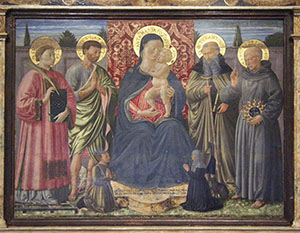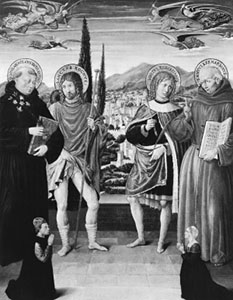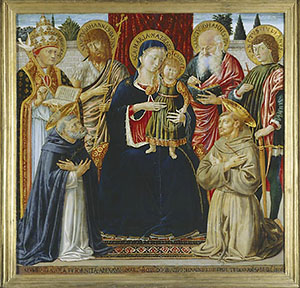
Madonna Enthroned with Saints, Opera del Duomo Museum, Pisa.

Altarpiece of the Four Saints, Metropolitan Museum of Art, New York.

Virgin and Child Enthroned with Saints Gregory, John the Baptist, John the Evangelist, Julian, Dominic and Francis, National Gallery, Ottawa.
In 1469, Benozzo received the prestigious job of completing the frescoes of twenty-six episodes from the old and new Testaments on the walls of the Camposanto (Graveyard) of Pisa - this grand series had been started in the thirteenth century, but he finished it himself in the fifteenth century.
The recognition he received from this work, coupled with the diligent and closely-monitored studio he directed, helped Benozzo acquire other official commissions like the Madonna enthroned and saints, which he and his collaborators realized for the church of San Lazzaro Fuori le Mura, (presently the property of the Pisa Primaziale), and the precious altar piece with the painting of the Madonna with Child, Saint Anne and donors, an iconography with a strong local tradition, and still accompanied by its original aedicula-shaped frame. Both of these panels can be dated to the early fourteen-seventies.
During this same period he produced the highly-esteemed panel with the Triumph of Saint Thomas of Aquinus for the urban Duomo (Cathedral) - Vasari reported that it was originally displayed behind the desk of the archbishop. The painting was confiscated during the Napoleonic suppressions, and since 1812 it has been preserved in the Louvre Museum. The Aretino biography also reports that the Pope in the lower right portion of the panel is Sixtus IV (1471-1484): this suggests that the painting could not have been executed prior to his election to the pontific order. The glorious God the Father is depicted in the arched section (above the rounded table), while St. Thomas of Aquinus is seated on a throne in the central section with his customary iconographic attributes, three open books in his lap and a fourth book turned to show the viewer the first phase of a famous piece of the Scolastica. Plato is positioned to the right, and to the left is Aristotle - allusions to the doctrine of Thomas, which reconciled ancient philosophical thinking with the teachings of Christianity.
Around 1473, Benozzo painted the Procession of the Magi for the Cathedral of Volterra. The painter had already depicted this same subject with superb style, execution and richness in the private Medici chapel in Florence. The fresco served as background scenery for a group of terracotta sculptures representing the Holy Family, executed in the studio of Della Robbia.
Pisa was among the many cities struck by the plague in this period, and between 1478 and 1480, Benozzo took refuge together with his family in the nearby town of Legoli, where he was engaged to realize a tabernacle with stories from the life of Jesus. On the main wall he depicted the Madonna with Child and four Saints. The other walls were frescoed with the Crucifixion, the Annunciation, the Incredulity of Thomas, the Archangel Gabriel, the Calvary Ascent and the Martyrdom of Saint Sebastian. Although a chapel was erected to protect the paintings in 1822, prolonged overexposure to weather conditions have left the frescoes in a fragmentary state today.
The so-called panel of the Four Saints and donors testifies to the terrible plague that struck the maritime city. The inscription gives the date as 1481, and the name of the client as Pietro di Batista d'Arigo, who had him prepare it as a votive offering after the same epidemic that had forced the painter to leave the city. The saints depicted in this piece (Nicholas of Tolentino, Roch, Sebastian and Bernardino of Siena) were chosen for their qualities as protectors against the deadly disease. The panel is preserved today at the Metropolitan Museum of New York. The National Gallery of Ottawa, on the other hand, exhibits the rich panel with the Madonna enthroned and Saints, remembered by Vasari and executed by Benozzo for his fellow citizens in Pisa - the Compagnia dei Fiorentini, which explains the inclusion of John the Baptist, protector of Florence.
After finishing the monumental work for Camposanto (Graveyard), Benozzo was called to Castelfiorentino in 1484 to execute the majestic tabernacle of the Madonna of the Cough: between 1490 and 1491 he returned to the same site to execute another tabernacle, even more imposing, entitled the Madonna of the Visitation.
Afterwards he once again found himself in Pisa to realize a series of frescoes in the convent of the sisters of Saint Benedict a Ripa d'Arno. This entire work, also remembered by Vasari, was completely lost, until recently when a niche was found containing fragments of the fresco of the Virgin and Saint John (not part of the Stories of Saint Benedict cited in the biography, however), currently the property of the Cassa di Risparmio (Savings Bank) of Pisa. It has been hypothesized that these paintings were part of the background of a lost crucifix sculpture, similar to the one executed for the Cathedral of Volterra. This monastery brought us the beautiful alter piece with the Sacra Conversazione ( Sacred Conversation ), which is currently preserved at the National Museum of Saint Matthew, where the detached fresco with the Crucifixion and Saints is also exhibited. This piece comes from the refectory of the female convent of Saint Dominic in Pisa, and was probably executed by Gozzoli after the governing of the Pisan monastery passed to the reformed convent of Saint Mark in Florence, an even that took place in 1488 at the will of Pope Innocent VIII (1484-1492). The detached fresco of the Saint Dominic that it exhorts to silence, from the same wall as the Crucifixion and ascribable, like the previous work, to the years between 1488 and 1490, is also preserved at the public National Museum.
Most likely, this same period also saw the production of the little arched panel with the Madonna with Child, which was executed for Pieve di Calci, a small district of the Municipality of Pisa. It was robbed in 1994, but fortunately it was recently recovered.
Serena Nocentini